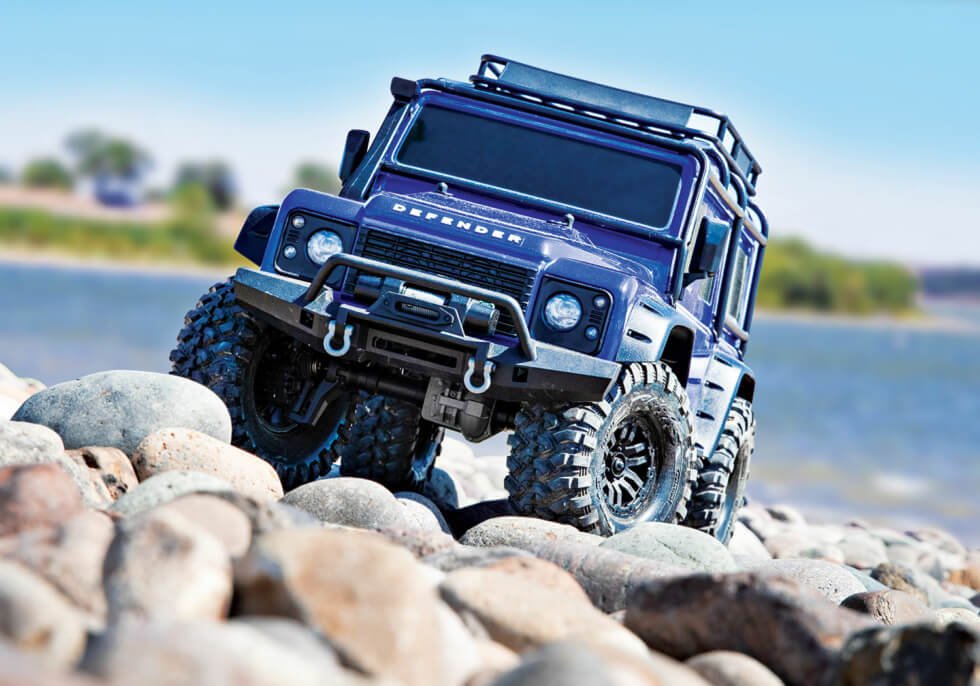Just because you’re a grown-up, that’s no reason to stop playing with remote-control cars.
On the contrary: RC cars for adults take things to the next level, bringing you miniature vehicles as high-tech as the real deal!
Whether you’re a hobbyist looking for a cool car to get started or a seasoned pro planning to upgrade, you’ve come to the right place.
We’ve got a complete list of the absolute best RC cars for adults based on durability, reliability, customizability, and, of course, price. We tested all the top-rated models on the market (sheer torture, right?) and winnowed it down to just the top picks for you.
Get ready to feel like a kid again, and have the time of your life!
BEST RC CAR FOR ADULTS
Contents
- BEST RC CAR FOR ADULTS
- Redcat Racing Gen8 V2 International Scout II
- Axial Yeti Jr. Can-Am Maverick
- Losi Mini-T-2.0 2WD
- ARRMA Outcast 4X4 8S BLX Stunt
- ARRMA Granite Voltage Mega
- Axial Wraith 1.9 4WD
- HPI Racing 101850 Vorza Flux
- ARRMA Limitless 6S BLX
- Traxxas Slash 2WD
- Tamiya Subaru Impreza TT-02
- Traxxas TRX-4 Trail Crawler
- BUYING GUIDE & FAQ'S

Redcat Racing Gen8 V2 International Scout II
Looking for an RC car that can do more, go faster, and play harder? You’ve found your top pick!
This bad boy is built with all the durability you’d expect from an offroad-capable SUV, courtesy of its 1.5mm C-Channel chassis rails, 4-Link suspension, and aluminum-threaded shocks. Everything is adjustable—wheel base, ride height, toe angle, approach and departure angle, suspension, and slipper clutch—and you can adapt the shock positions to your exact specifications to suit whatever race or terrain you’re running.
The car’s body is made with super-tough-yet-lightweight aluminum, a hard plastic grill and rock sliders, even folding mirrors that are just like the real thing. With a brushed 17T 550 motor, 25kg waterproof steering servo, Crawler ESC, and cutting-edge 2.4 GHz radio system, it’s the “big boy” RC car of your dreams.
Pros
- High-strength chassis rails for increased durability
- Adjustable wheelbase, ride height, toe angle, and approach and departure angles
- It’s customizable to increase your fun
- It has amazing attention to details
Cons
- Batteries don’t come included in the pack
Specs
- Scale: 1/10
- Material: Metal, aluminum, rubber, plastic
- Speed: 4-5mph

Axial Yeti Jr. Can-Am Maverick
When offroad adventures beckon, the Axial Yeti Jr. answers the call in style. At 1/18 scale, this heavy-duty four-wheel drive offroader can handle the most rugged terrain with ease.
Built with independent front suspension that offers supreme maneuverability and responsive handling, it’s elevated for better ground clearance with built-in adjustable threaded and oil-filled coilover shocks as tough as any real-life vehicle. Thanks to its 37T brushed electric motor, the Can-Am Maverick X3 body, and all-terrain Maxxis Bighorn 2.0 radial tires, the Yeti Jr. will rev up to impressive speed (13 MPH) even on rough-and-tough ground.
Pros
- Adjustable coilover oil-filled shocks
- Strong, durable, and waterproof brushed motor
- Aluminum CVDs for stability at high speed
- It’s equipped with a hinged body mount
Cons
- Doesn’t perform very well on rocky terrain
Specs
- Scale: 1/8
- Material: Metal plastic
- Speed: 13mph
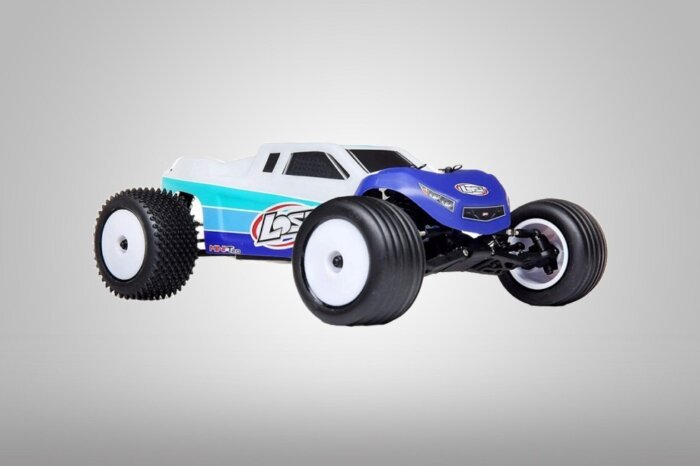
Losi Mini-T-2.0 2WD
Bring the Daytona 500 into your own backyard RC race track, and let the Losi MINI T-2.0 2WD rip around the course at up to 30 MPH. It’s built with a sleek, aerodynamic body—hard plastic atop an aluminum chassis—and a powerful Brushless Motor/ESC 2-in-1 combo that delivers torque enough to pop a wheelie and hit those top speeds in record time.
You’ll love the RC car’s above-average runtime, courtesy of the Dynamite Reaction 2.0 7.4V 2S 800mAh 50C Li-Po Battery. And if you’re the sort of operator who likes to tinker, there’s a whole line of option parts you can use to upgrade from a stock car to a vehicle built just the way you want it. Now that’s an RC car you can love!
Pros
- Lots of power with brushless 2-in-1 motor
- Powerful 7.4-volt 2S 800mAh batter
- Front directional tires and a rear-step pin for better control
- Ball bearings that boost the vehicle’s performance
Cons
- Reported issues with its servo
Specs
- Scale: 1/18
- Material: Aluminum, metal
- Speed: 30mph
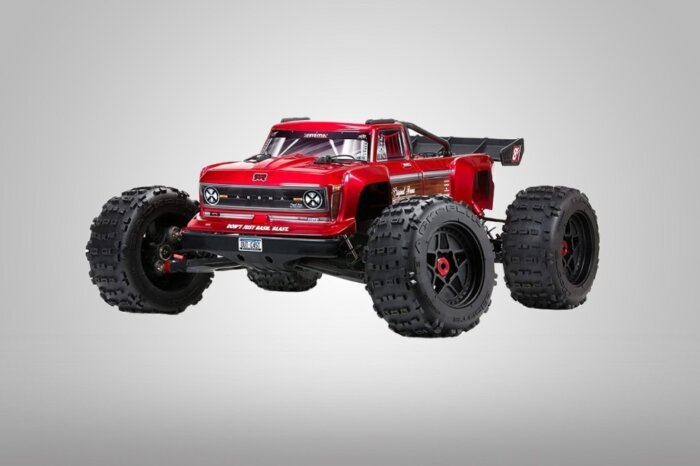
ARRMA Outcast 4X4 8S BLX Stunt
Durability is the name of the game with the ARRMA Outcast 4×4 8S BLX Stunt. Sitting atop its extra-rigid anodized aluminum chassis is the multi-structured center brace system that provides additional support for the ultra-tough OUTCAST 1/5 8S truck body. With the multi-terrain dBoots BACKFLIP tires mounted, you’ve got the power and traction for wheelies, spins, and flips galore. When it comes time to tweak performance, you’ll love how easy it is to access both rear and front differentials, as well as the chassis braces, power module, and electronics module.
Plus, it’s entirely customizable from the wheels up. The ARRMA modular platform lets you swap out any part for something new, letting you build the perfect RC car from scratch, or adapt the stock parts to your desires. It’s big, tough, and rugged—the RC car for guys who like heavy-duty trucks!
Pros
- Laser-etched anodized aluminum construction
- Many customization options with adjustable battery boxes
- Rear lower chassis brace
- Metal inserts molded into the front steering knuckles
Cons
- A bit weak rear control arms
Specs
- Scale: 1/5
- Material: Aluminum, Alloy Steel, Metal, Rubber
- Speed: N/A
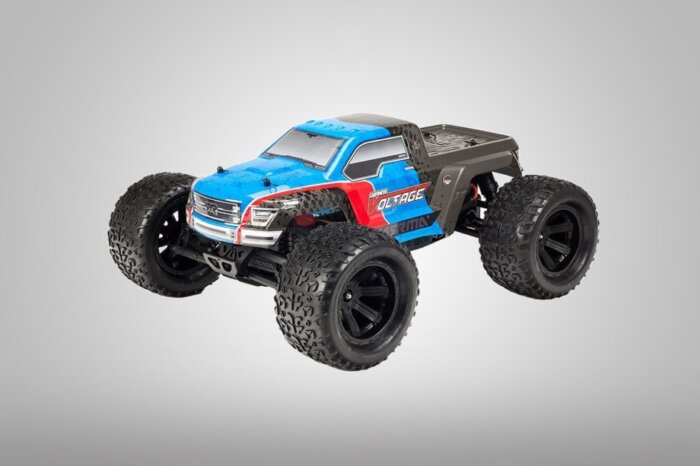
ARRMA Granite Voltage Mega
Want to get started RC truck racing but don’t have the skills to build your own? That’s when you need the ARRMA Granite Voltage Mega. This beast of an RC truck is the perfect option for beginners and hobbyists who want a superior vehicle right out of the box.
With this truck, you get total waterproofing, all-terrain handling, and a body tough enough to drive away from any impact unscathed. It even hits speeds of 20 MPH!
And if you’re worried about not getting enough battery life, you’ll find the built-in NiMH can be swapped out for a LiPo power source to extend your runtime and increase performance.
Pros
- Double-wishbone front, rear suspension, and a wide stance
- Durable and strong multi-terrain dBoots Copperhead tires
- It comes with electronics, radio, an NiMH battery, and a charger
- Use LiPo battery if you want to boost its performance
Cons
- Battery charge issues
Specs
- Scale: 1/10
- Material: Plastic
- Speed: 20mph

Axial Wraith 1.9 4WD
Take this bad boy rock crawling, mud running, or sand duning, and it’ll be a winner every time. It’s designed specifically for the harshest offroad terrain, with higher ground clearance, a full-tube frame chassis, all-metal gear AX10 transmission, and WB8 HD wildboar driveshafts that will never break or crack. Thanks to its dual slipper clutch and 4-link rear suspension, you get both top speeds and superior handling in one tough little vehicle. On even the toughest course, the oil-filled coil over shocks will tackle any obstacle with ease.
And boy, is she a beauty! The body is detailed to perfection, with a molded V8 engine replica beneath the hood, plastic radiator and grille, LED lights, and sturdy rollover frame.
Pros
- It has a full-tube chassis and a metal gear ax10 transmission
- Detailed body design, radiator, fender, V8 engine, and LED lights
- Easy access to the electronics and adjustable battery tray
- It’s got many upgradable features to enjoy
Cons
- It doesn’t come with some essentials you need
Specs
- Scale: 1/10
- Material: Polypropylene
- Speed: N/A
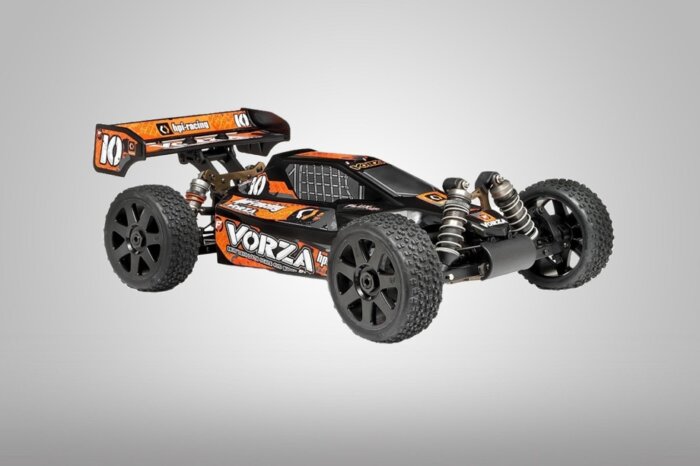
HPI Racing 101850 Vorza Flux
Raw power meets cunning design in this beautiful, sleek rallycross RC car. With an aerodynamic design, an eye-popping paint job, and ultra-powerful HPI Flux Tork 2200 brushless motor, you’ve got a winner on your hands.
This RC car is an exact replica of the 2008 World Championship-winning D8 buggy, and can reach speeds of over 60 MPH! The adjustable battery tray lets you switch out NiMH batteries for LiPo, giving you even more power and a longer runtime with just one small tweak. Thanks to the fully adjustable drivetrain and suspension, you get better handling at high speeds to make crisper, harder turns on even the tightest corners.
Pros
- Strong HPI Flux Tork 2200 brushless motor
- Replica of the World Championship-winning D8 buggy
- It has an adjustable battery tray, suspension and drivetrain
- Strong drivetrain as a result of D8 spiral-cut worm gear diffs
Cons
- It doesn't come with batteries
- Front design gets damaged easily
Specs
- Scale: 1/8
- Material: Plastic
- Speed: 73mph
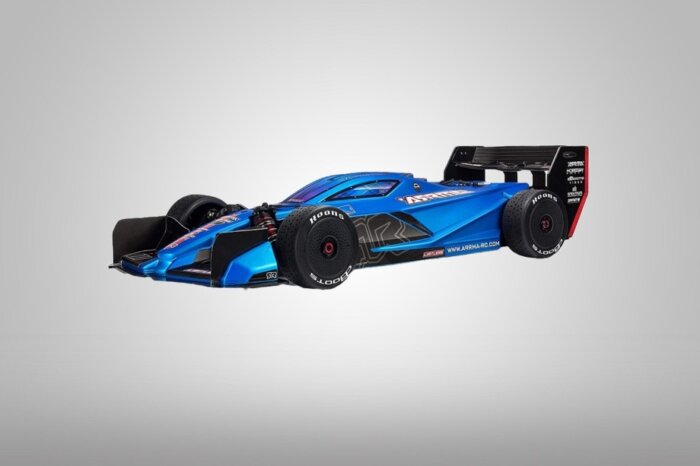
ARRMA Limitless 6S BLX
Your rivals won’t be able to touch this sleek and stylish RC street car. It’s built specifically for smooth tracks, but you’ll be amazed by how well it handles even on rough terrain. You can customize it fully to suit your race specs—the perfect option for advanced RC drivers.
You’ll love how well it blends maneuverability with reliability, durability (strong steel drive shafts, anodized aluminum chassis, and hard plastic body), and excellent aerodynamics. The heavy-duty 4X4 drivetrain gives this RC car a heck of a lot of “zoom”, and the all-metal internal components will extend its lifespan exponentially. Though you’ll need to buy a lot of accessory components yourself (raising the cost of the vehicle), it’s one of the best choices for a street racer, hands down.
Pros
- Superior aerodynamics with a full-width front splitter
- It’s got an anodized aluminum chassis
- Dual XL battery trays for customization
- Rear diffuser for boost grip and downforce
Cons
- It requires quite a few accessories before you can use it
Specs
- Scale: 1/7
- Material: Aluminum, metal
- Speed: N/A
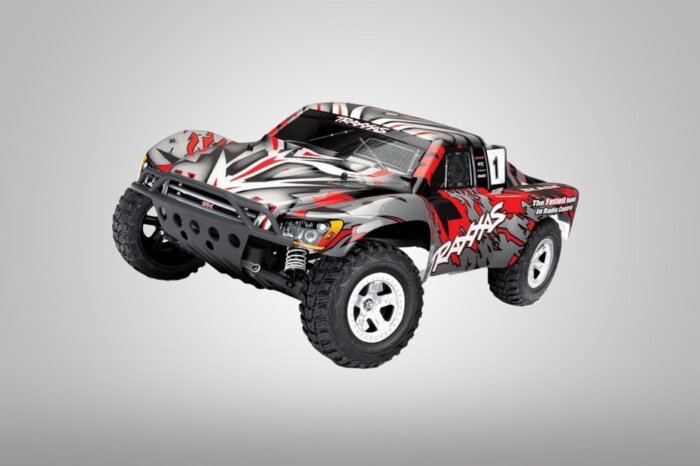
Traxxas Slash 2WD
This Traxxas RC truck has a striking, bold design. It’s also packed with tons of features to ensure many hours of fun. It’s tough and rugged. This RC truck has a powerful Titan 12-turn 550 motor as well as XL-5 ESC. This ensures that you can reach speeds up to 30mph.
It’s built with waterproof electronics. This means you can enjoy riding this truck even in bad conditions, like rain and snow. It’s got a cooling fan in its design to send air through vent tunnels that are located in the motor plate. This helps to keep the RC truck’s temperature down for faster and longer runtimes.
This RC car’s rear-wheel drive is designed to enable you to fly over jumps and make heart-stopping turns. Its four-wheel independent suspension mimics real-world driving as much as possible, and it won’t get stuck when crawling over rocks, as it has a chassis design with good center ground clearance. It has been built with a bell crank steering system that enables precise handling.
It doesn’t come with a charger or battery, which are sold separately. While the Slash 2 offers a speaker that produces real-life engine sounds, this model doesn’t.
Pros
- Powerful Titan 12-turn 550 motor as well as XL-5 ESC
- It’s built with waterproof electronics
- It has a four-wheel independent suspension
- Cooling fan and vent tunnels located in the motor plate
Cons
- Charger or battery are sold separately
Specs
- Scale: 1/10
- Material: Metal, plastic
- Speed: 30mph
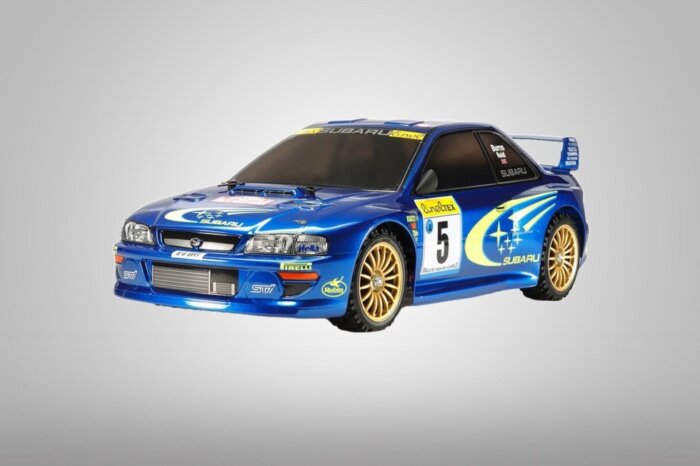
Tamiya Subaru Impreza TT-02
This model car is a replica of the Subaru Impreza WRC that participated in the Monte Carlo Rally in the 1999 World Rally Championship. It’s more than just an RC car – it’s a kit that comes with clear assembly instructions so it’s ideal for people who want to build cars. This model car’s assembly makes it easy to use.
It has an encapsulated four-wheel drive, an electronic brushless/brushed speed controller, and a 540cc electric motor for power. This TT-02 chassis offers a variety of tuning parts that you can purchase to make the car stable and fast.
The car’s polycarbonate body is an accurate representation of the real-life rally car, which is pretty cool. Its shaft-driven 4WD chassis has a longitudinal layout, so the battery is on the left and the motor on the right so that you can enjoy greater stability.
It has identical suspension arms and uprights, which make it easy to assemble as well as maintain. People who have purchased this RC car have said that this kit is designed well to make it easy for you to customize it to your heart’s content. This RC kit comes with masking and decorative stickers included.
You will need to purchase some accessories to use the RC car, and these are sold separately. These include a remote control with receiver, a 7.2 V NiMH battery pack, a charger, and a steering servo. The car also requires a color spray to be purchased.
Pros
- TT-02 chassis offers a variety of tuning parts that you can purchase
- Its shaft-driven 4WD chassis has a longitudinal layout
- Its shaft-driven 4WD chassis has a longitudinal layout
- Battery is on left and the motor on the right for greater stability
Cons
- Accessories to use the RC car are sold separately
Specs
- Scale: 1/10
- Material: Polycarbonate
- Speed: 20mp
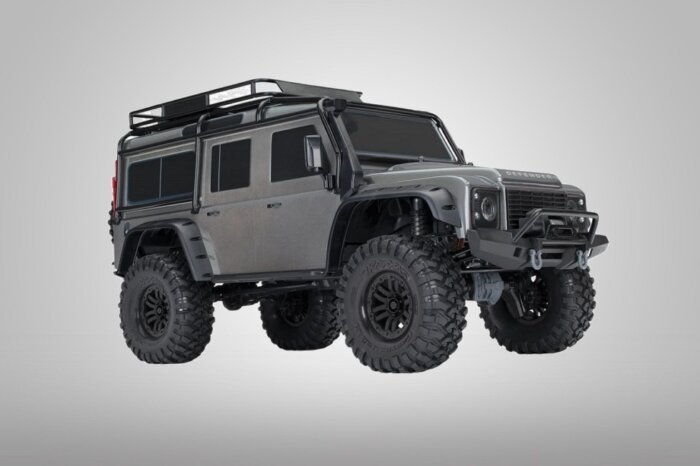
Traxxas TRX-4 Trail Crawler
Get ready for a smooth ride on any rough terrain. This heavy-duty offroad RC features portal axles that both maximize ground clearance and minimize chassis torque twist, as well as adjustable locking differentials to improve vehicle handling. The built-in 21T Titan 550 motor and XL-5 HV ESC are compatible with both NiMH (6 or 7-cell) and LiPo (2 or 3-cell) batteries, making it easy to increase battery life and runtime or re-use components from other RC cars. When the going gets rough, the two-speed transmission lets you switch into a lower gear to blast over any obstacles.
The electronics are totally waterproof, so you can take this RC car off-roading through mud, snow, or rain worry-free, and the sealed ball bearings will always glide smooth. When the
And, of course, the RC car looks absolutely badass with its Land Rover Defender body, complete with spare tire and functional accessories.
Pros
- Innovative portal axles for greater clearance and chassis torque twist prevention
- Oil-filled coil-over GTS shocks for smoother experience
- Enables to lock and unlock the front and rear differentials
- Two-speed transmissions for 4WD pulling torque or speed on a trail
Cons
- Original digital servo is of poor quality
- To increase the durability of this car purchase skid plates
Specs
- Scale: 1/10
- Material: Alloy Steel
- Speed: 30mph
BUYING GUIDE & FAQ'S
RC cars for adults can be a fun—albeit, expensive—hobby.
From stock to custom-built, you’ll find a huge range of options to choose from when buying your first RC car. Beginner models will typically cost less, but the fancier and more advanced the RC car, the pricier it’s going to get.
Below, we’re going to walk you through everything you need to know when looking for an RC car, including the types available to you, the various designations (“toy” and “hobby” grade), and factors to consider.
By the end, you’ll know enough to shop smart and find the right RC car for your personality and racing plans!
Types of RC Cars
Let’s start off with the basics: the different types of RC cars available.
RC cars are as varied as the vehicles they are built to imitate. You’ve got so many choices of vehicle types, but they start with either on-road or off-road.
Off-road vehicles include buggies (tires aren’t protected by wheel arches), short course trucks (which look like sedans with a built-in truck bed), and, of course, monster trucks (great big beasts of oversized trucks). You’ve also got options like “truggies” (a combination of truck and buggy) and crawlers (designed for rock crawling) These are built to be driven over rough, uneven, rocky, and sandy terrain, and are typically tougher but slower.
On-road vehicles include bash cars, drag racers, formula racers, and drift racers. They tend to be lower, have tires with better grip on concrete, and will reach higher speeds. These are built to be driven on race courses and race tracks.
Toy vs. Hobby Grade
One designation you’ll often encounter when shopping for RC cars for adults is “grade”—typically “toy grade” or “hobby grade”.
Toy grade vehicles are typically the cheaper option, stock models that you can buy and race immediately. They’re great for beginners and offer some customization, but usually, what you see is what you get.
Hobby grade vehicles are created with a hobbyist in mind, someone who is dedicated to not just racing, but also tinkering with their vehicle and optimizing performance. They require some level of experience and skill to operate, require maintenance after every use, but allow for much greater customization. They also have significantly more power than toy-grade cars, have larger interior components that can be replaced or upgraded, but also cost significantly more.
Buying RC Cars for Adults: Important Factors to Consider
By now, you’ve probably decided whether you prefer an off-road or on-road vehicle, and whether you’re a hobbyist or just want a toy RC car to drive for fun.
But that’s just the beginning! There are a lot more factors that need to be considered before you click the “Buy Now” button.
Speed – RC cars can typically manage speeds upwards of 15 MPH, but you’ll find models that can hit 30, 40, even 60 MPH! For beginners, you won’t need a vehicle that runs much faster than 30-40 MPH—in fact, it’s better if you start out a bit slower and increase your speed as you gain experience. If you’re driving a hobby-grade car, you can always upgrade the motor in time.
Style – What type of car do you want to drive? Do you want to be a Formula One racer, a Monster Truck driver, or a rock crawler? You’ll find that there are RC cars designed as exact replicas of your favorite vehicles—from muscle cars to Grand Prix winners to off-roaders—with fully customizable paint jobs and add-ons. You can literally buy or build your dream car!
Scale – RC cars typically range between 1/16th and 1/10th of actual vehicle size. Some models can be found in up to 1/5th scale, which are both pricier and much larger. For most racing and casual driving, it’s better to buy the more common scale. Not only are the vehicles themselves more affordable, but the parts needed to upgrade, customize, and repair are also easier to find.
Propulsion – There are basically two sources of propulsion for RC cars:
- Nitro cars use miniature combustion engines just like the ones used in motorbikes and lawn mowers. These run on a combination of oil, methanol, and nitromethane. They require a lot more servicing and maintenance, generate more noise (making them illegal in some suburban tracks), but they can typically reach higher speeds.
- Battery-powered cars use LiPo (pricier/better) or NiMH (cheaper/lower-quality) batteries to power the vehicles. Essentially, the bigger the battery, the more power it can hold, meaning faster speeds and/or longer runtime. The terms “brushed/brushless” refer to the brushes (small carbon blocks) inside the electric motors. Brushless vehicles are faster, but also pricier.
If you’re going to buy a battery-powered car, it’s highly recommended you buy a spare battery (or two). You’ll have to research which charge and discharge plugs are used by which models before buying a spare, so make sure you buy the same model with the same voltage (S rating) but higher discharge rating (C rating). Finally, make certain it’s sized to fit in the hole on your RC car.
Completion Level – Some vehicles come RTR (ready-to-run) and are designed to be complete vehicles that you can assemble right from the box. You’ll need to pick up a charger and battery, but otherwise, you’re good to go.
Buildable kits, however, only include the basics: tires, wheels, chassis, and body. You get to choose your own electronics and motor to finish building it, and you’ll have to do the work of actually assembling all the smaller pieces.
Most first-time racers opt for RTRs, while many hobbyists prefer to build their own RC cars using buildable kits.
2WD vs. 4WD – 4WD offers more power and traction on rough terrain, but 2WD cars are less likely to sustain drivetrain damage, and have fewer breakable components that may need replacing. Rear-wheel 2WD vehicles are better for wild spins, but 4WD offers better control.
Spare Parts – This is absolutely a critical factor to take into account! The more you run the RC car, the more likely it will be to break down or sustain damage (just like your real car). You’ll want to have easy access to replacement and spare parts, as well as additional mods to customize or upgrade the vehicle.
Factor this into your budget, as well as your buying decision. You want to make sure you’re choosing a vehicle from a brand that has easily available replacement parts (preferably located or in shipped to your area).
Competitive Requirements – If you plan to enter RC car races, you need to make sure your RC car adheres to the rules and guidelines established by Remotely Operated Auto Racers (ROAR), the entity that governs RC racing in the U.S. and Canada. These guidelines dictate the vehicle classes (stock, open modified, super stock, etc.) as well as the rules of the various types of tracks.
Make sure to read over the guidelines before you buy the RC car. You want to be sure your vehicle meets the standards and specs, otherwise you might be looking at a costly overhaul/rebuild before you’re permitted to enter races on a local, regional, or national level.
FAQs:
Where do you drive your RC car?
Pretty much anywhere you want! Off-roaders can hit forest trails, beaches, lake shores, even rocky riverbeds. On-road vehicles are perfect for skate parks, sidewalks, boardwalks, park lanes, and suburban streets. And, of course, for both types of vehicles, there are always local RC car race tracks where you can test your skills!
Note: Be aware that your city will likely have laws governing the use of RC cars (especially high-speed models) in public. It’s worth doing a quick Google search to find out what the regulations for operating nitro- or battery-powered vehicles in your city are.
What is RC bashing?
Most people think of RC car driving and immediately think of racing on tracks or courses. But for those who want fun without all the structure and regulations, there is always RC bashing. The term “bashing” is racing without rules, perhaps on an unsanctioned course, or even off a course. It’s a fun way to test the limits of your vehicle and driving skills. Sure, the vehicle may end up getting bashed around (hence the name), but that’s half the fun!
How long does a RC car battery last?
The battery life will differ depending on the type of battery you use, the S-rating and C-rating, and how long you have been using it.
Batteries have a pretty standard lifespan of 150-300 charges, so the more frequently you use the battery, the faster it will lose its charge because the fuel cells are less efficient at storing electricity.
- NiCD batteries will usually last between 12-15 minutes on a single charge, and have a shelf life of 1-3 years.
- NiMH batteries will usually last between 15-20 minutes, and have a shelf life of 3-5 years.
- LiPo batteries may last up to 30 minutes, and have a shelf life of 2-4 years.
Just remember: the bigger the engine and the faster you drive, the more energy is being pulled from the battery, so the faster it will lose its charge.
How much does a good RC car cost?
Starter RTR models will run you upwards of $200. You will find some budget toy-grade models in the $50-$199 range, but they will usually be geared toward very beginners and won’t last long.
The “sweet spot” is usually between $300 and $500. In this price range, you’ll find both RTR and buildable vehicles of excellent quality.
Why are RC cars so expensive?
The price of your RC car depends on a few factors:
- RTR or buildable kit (kits cost more because you have to buy the motor and electronics separately)
- Power source—nitro is the most expensive, with LiPo batteries being significantly pricier than NiMH and NiCD batteries.
- Cost of replacement parts
- Scale of the vehicle—the larger the vehicle, the pricier it will be
If you want to keep it cheap, stick with toy-grade vehicles or hobbyist vehicles on the budget end of the spectrum. Top-end models run faster, last longer, handle better, but have a price tag to match!


